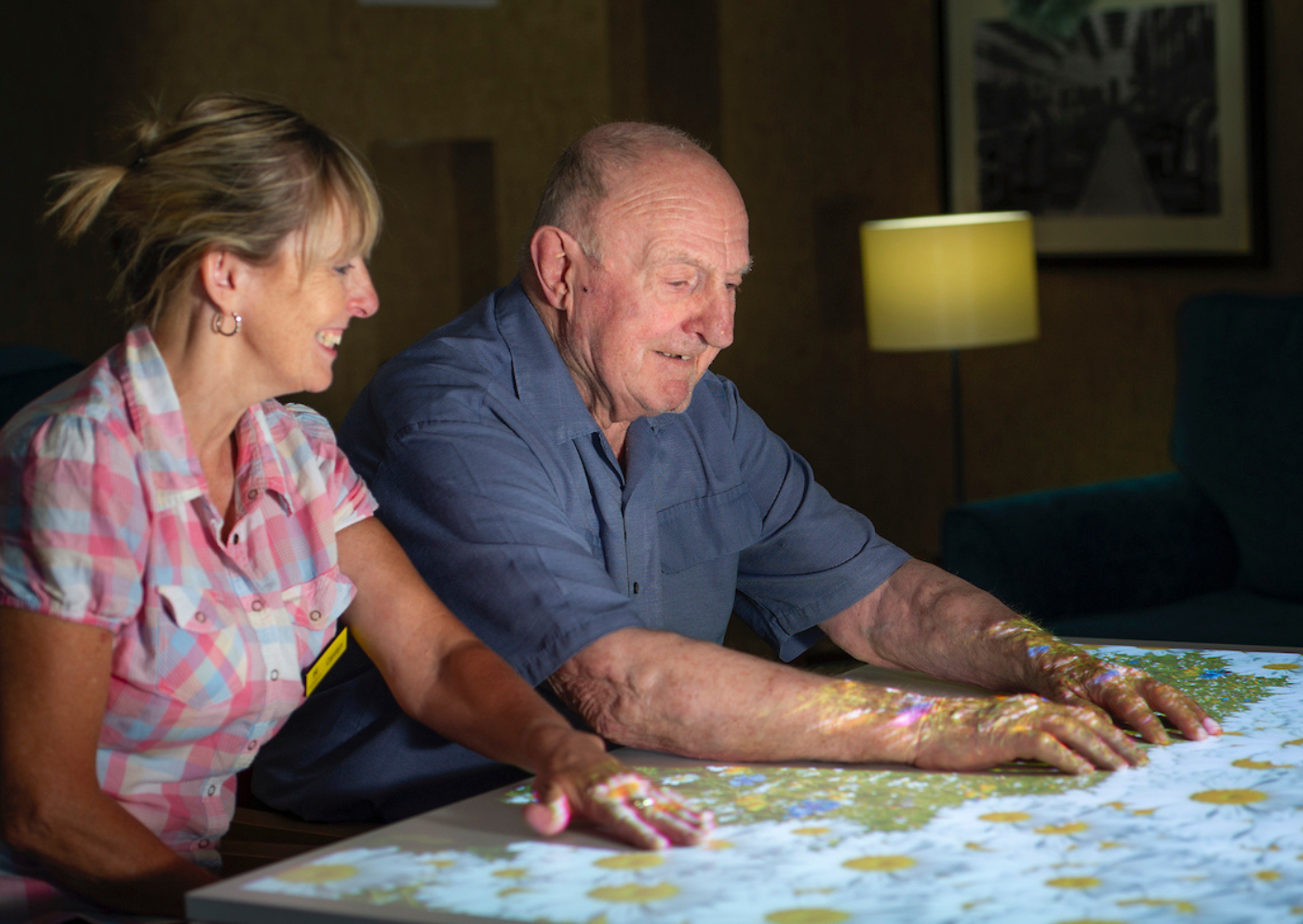
Your first port of call should be to look at the rating of the home on the Care Quality Commission website to see whether the home is rated safe, effective, caring, responsive and well-led. In addition to the CQC rating we think that there are a number of ways to judge for yourself whether a home is providing good quality dementia care and if it is bringing tangible benefits to residents.
As part of our commitment to providing outstanding dementia care, we ask the following questions in each of our homes. We’re sharing them below to help you make the best decision for your loved one.
It’s vital that the care home you choose for your loved one is adapted for people living with dementia so that they can live fulfilled and meaningful lives. It’s also essential that the care environment enables the care team to provide the right level of care and that the care environment is positive and conducive to wellbeing.
Every element of the home’s design should be optimised to support dementia care, right through from the lighting, to signage and outside space. At Hamberley Care Homes we have a team of developers, architects and builders who have significant experience in designing and building care homes throughout the UK, and have achieved awards for the developments.
Here’s what our bespoke dementia care design recommendations look like:
Living spaces in care homes should make use of natural light and be well-lit. Softer lighting should be available during night time and alarms and noise should be minimised to create a relaxing and nurturing space.
For example, in our homes we try to minimise unwanted stimulation to create quiet, calm areas and help encourage more restful sleep.
In our spa bathrooms we are able to facilitate a more relaxing experience using music, lighting and sensory input – all tailored to our resident’s personal preferences.
Regular access to outside space and fresh air is essential to maintain positive wellbeing but sadly people living with dementia often miss out on this essential health experience.
Outdoor sights and smells, and sounds of wildlife, are known to provide stimulation, facilitate interaction and conversation prompting reminiscence of the past.
All of which bring huge benefit to residents with dementia, reducing their levels of agitation and encouraging them to be more active.
To that end all of our homes have landscaped and accessible gardens that can be enjoyed by residents and families alike. Our homemakers support our residents to get fresh air daily (if the resident would like to) and regular trips to green spaces are also organised.
We encourage outdoor activities such as green gyms (outside exercise classes) and many of our homes have gardening clubs for residents and also members of the public. So it’s a social activity too.
Dementia care guidelines indicate that tasks such as planting flowers, in particular the more fragrant varieties, have real sensory benefits, bringing scent into the air and stimulating the senses.
Inside our care homes, we have bright social spaces available on all floors and bar and café areas to help residents and families interact and continue with hobbies and activities.
Our seating is sourced from a range of suppliers providing comfortable armchairs and dining chairs, at appropriate heights, using suitable materials and providing the required support.
When reviewing a care home make sure that navigation tools and signage are designed according to recommended dementia guidelines with use of appropriate colours and images.
Don’t forget to look out for placement of pictures and objects to assist with way finding and orientation – are they used to help residents find their way around the home or do they lead to extra confusion?
Consider how the staff comply with these guidelines too. For example our staff don’t wear uniforms to ensure we have a more home-like environment but instead they wear bright yellow name badges so that they are clearly identifiable as team members.
Don't forget the more mundane details – like flooring. Our flooring is smooth but non-slip to encourage movement and they are painted in matt, in contrasting colours to the walls, to help residents navigate more easily and with greater confidence.
Ideally a care home should replicate daily life within the resident’s home as much as possible, promoting regular movement and tasks.
So instead of having a set schedule of activities, where timing and location are fixed, residents should be facilitated to take part in more naturally occurring activity.
Activities such as helping to prepare a small snack or playing a game of cards when residents feel like doing so.
As part of our care plans we monitor the changing care needs of our residents, and our Homemakers are there to provide extra support as and when it is needed.
Our designated Wellbeing & Lifestyle Coach understands that residents may experience ongoing visuo-spatial and visuo-perceptual changes so these are regularly monitored and activities are adapted to suit each individual’s needs.
Our homes are especially designed to promote social activities for people living with dementia and also to include their loved ones or family members.
We hold monthly Dementia-Friendly Cinema Clubs and our beauty salons are welcoming and accessible places for everyone.
It’s worthwhile checking that the home you are considering for your loved one is keeping abreast of the latest technological offerings within care. This way you can be confident that their dementia care is up to date with the latest developments.
At Hamberley Care Homes we’re always looking for ways that we can improve the care experience of our residents. We actively seek out technology and applications to use to enhance our care or boost the wellbeing of our residents.
Our homes are subscribed to Person Centred Software (PCS) which uses Mobile Care Monitoring software to assist with creating person-centred care plans for residents. Staff have access to handheld devices containing the software which links a person’s assessment to their individual care needs.
This ensures residents consistently receive the care they need and allows instant access to information and reporting, saving time and giving staff more time to spend with residents.
Our homes use the interactive sensory device, Mobii, also known as the ‘Magic Table’ to help promote social activity and connections in our residents who are living with dementia. The residents, and also staff members, play interactive games that stimulate verbal and physical responses, something which can often begin to decrease with dementia. Mobii won the National Dementia Care Outstanding Product Award 2018 for the many opportunities the system brought people at all stages of dementia.
We have also engaged with and trialled ‘Exergames’ which is a software programme and equipment that provides an interactive platform to boost physical movement. This in turn reduces falls as it specifically targets balance and strength training.

Not only is it vital to ensure that your loved one receives a varied and nutritionally complete diet whilst living in a care home but it is also important that the mealtime experience is not overlooked. Mealtimes are an important opportunity for social interaction and to implement many aspects of person-centred care for people living with dementia.
At Hamberley Care Homes we have developed our own Catering Standards that all homes follow. To support with the implementation of these standards, we have engaged an expert chef and dietitian to monitor and assist the catering teams within the homes. This ensures that awareness and knowledge of the standards is embedded across our homes, and our residents receive the care and attention they deserve.
As outlined in the standards a healthy, well balanced diet is vital for residents. Our homes offer a variety of nutritionally dense meals, and snacks are available even out of kitchen operational hours. We know that mealtimes provide structure, orientation and opportunity for social engagement to a resident’s day.
However we are aware that some residents have disrupted sleep patterns and do not wish to eat at conventional times, so we make our meals available whenever a resident would like to eat them.
There should be purposeful interaction for example, regarding what food and drink the resident is having, with encouragement to smell the food and make it an enjoyable experience. Especially if the resident needs encouragement to eat and drink.
This support should take into account the associated visual and perceptual impairments the resident may have as well as the cognitive or attentional challenges the resident may face.
The environment should be set to indicate a mealtime is taking place and tables laid to encourage residents to sit together to enable social interaction. Any distractions and sensory overload should be avoided, for example soft background music can be played, but blaring TV’s should be switched off. Care plans should document resident’s preferences for their mealtime experience and should guide staff in how to support them accordingly.

Knowing that your loved one is being cared for by a trained member of staff is essential.
In order for us to provide an outstanding care experience, our specialist dementia teams are trained in supporting and valuing all our residents as individuals and responding to their unique needs.
We recognise that advances in dementia care are happening all the time and our staff are part of a continuous training programme that keeps them up to date with best practice and the latest innovations in care.
All of our team attend training sessions in dementia awareness and within each of our care homes we have identified team members who become our staff ‘Champions’.
These Champions receive additional, more advanced training so that they can guide our staff teams and identify areas that we need to adjust our support levels within each home.
We also receive guidance from leading healthcare professionals relating to dementia, including:
Understanding the latest research and developments in dementia care can be overwhelming for families so it’s important to know that the care home looking after your loved one is taking care of this for you.
Details of your home’s approach should be made available through their website and explained in their newsletters or other family communications.
If you have questions or want to know about their approach in more detail then we recommend speaking directly to the home manager or a member of their Quality Assurance team.
At Hamberley Care Homes all our work is research-led and our clinical teams are committed to sharing best practice and working collaboratively with support groups and research bodies to improve the lives and wellbeing of people living with dementia.
We regularly engage with consultants and experts in dementia to ensure that all our interventions are evidenced based. Through our Innovation and Best Practice forum we review and discuss current evidence and guidelines supporting our care and practice.
Our residents and their family members are always welcome to contact us and we can talk through our approach in more detail with them.




We've prepared a checklist for you to download and use when you're selecting a care home.
Simply click the image to download and print. To find a care home that ticks all the boxes, contact the Hamberley Team to find your nearest care home.